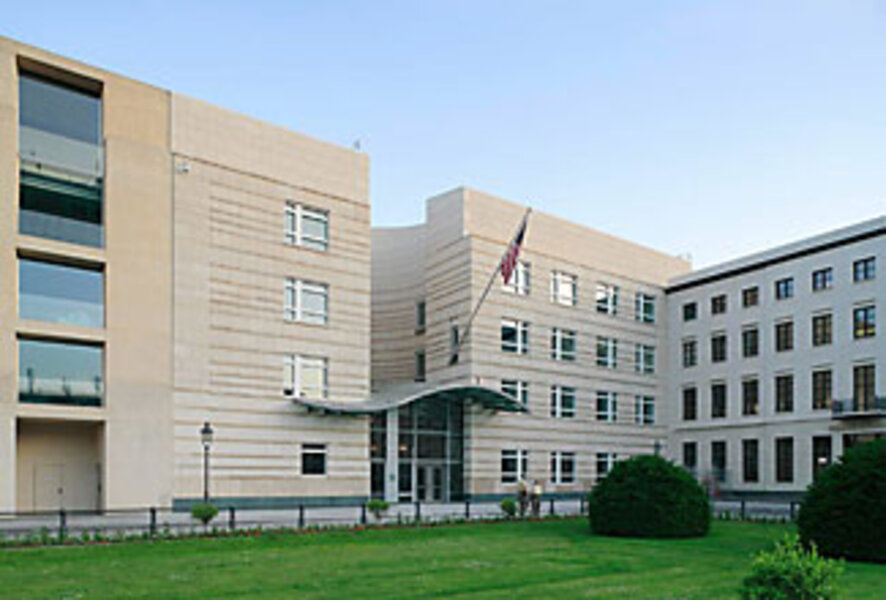U.S. to open Berlin embassy on symbolic land
Loading...
| Berlin
The July 4 inauguration of the United States Embassy in the heart of this city is the last stone in the postwar edifice of a whole and free Europe, diplomats say.
But Berliners are calling the building – perhaps unfairly – an architectural 'triumph of banality' more fitting for a Kansas cornfield.
Either way, the event is rich in symbolism. The embassy reopens on land the US owned in 1941 when Adolph Hitler declared war on the US. The property abuts the Brandenburg Gate, a noman's land in the cold war, and is a block from the German Reichstag.
"It's a very big piece of history," says John Kornblum, a former US ambassador. "It's a look back and a look forward at a time when Europe is going to change very fast, at a time when the Germans see they can't always live under a big US umbrella."
The German reaction to the new embassy has been almost universal dismay at the building itself with some saying the security-manic Americans should have built it in the relatively safe suburbs.
"We could have built an embassy out in the woods at half the cost and twice the security," current US ambassador William Timken Jr. said early this year. "We are here as a symbol of our desire to be a partner to Germany."
Mr. Kornblum, now a Berlin resident and counselor for the firm of Norr Stiefenhofer Lutz, says, "We were determined to be here because of the history.... If the Nazis couldn't chase us off the site, we weren't going to let the mayor of Berlin do it."
The site, first procured in the 1930s, was returned after the Berlin Wall fell and then haggled over for more than a decade. The US Congress cut building funds by $50 million to $130 million. Feelings in Berlin ran high, with one former mayor saying the US should put a McDonald's restaurant up instead. The State Department allowed a security accommodation when Berlin city officials refused to push a safety zone out into prime Pariser Platz real estate. Indeed, Pariser Platz, anchored by the four-horse chariot – topped Brandenburg Gate, is one of the most significant spaces in Germany – the place where East Germans poured into the West in 1989, and close to where President Reagan challenged Soviet leader Mikhail Gorbachev to "tear down this [Berlin] wall," the symbol of divided Europe.
When the construction scaffolding for the new embassy was torn down earlier this year to reveal a modest postmodern design by the US architectural firm of Moore Ruble Yudell – German papers piled on with a torrent of scorn.
Defenders say criticism smacks more of a political harangue at the image of 2008 America than a fair-minded assessment of a government building whose design was agreed to by a binational jury in 1994.
German negative reaction of the building split between a critique of a drab and an expressionless design and a perception of clunky security. The Süddeutsches SP Zeitung termed it "Fort Knox at the Brandenburg Gate."
The Berliner Zeitung wrote, "It is hard to believe the US – the country where public relations was born and where the art of symbolic exaggeration is mastered like almost nowhere else – has decided to occupy this location with a piece of run-of-the-mill architecture that says nothing."
Die Welt opined: "…Only the Chinese embassy is uglier."
Leading American expats in Berlin seem genuinely stung by the reaction. Many argue that the structure was specifically designed to blend in with the rest of the Pariser Platz square. The entrance is bordered by two banks, a glass-fronted art museum, and a classic German hotel.
Standing at the Pariser Platz, Gary Smith, director of the American Academy in Berlin, calls the flood of criticism "ridiculous.… [T]his square now looks like the future – cosmopolitan and open."
Mr. Smith, whose father-in-law was a juror for the 1994 design panel, says there was much debate over classic and modern designs – but the final priority was to complement neighboring structures.
The new embassy "blends well with the ensemble of buildings on the most important square in Germany," Smith says. "It isn't the most avant-garde of structures, but I'm glad the US chose discretion over pomposity. It is a subtle solution to a very difficult space."
One US source involved with the embassy project says, "nothing has changed in the design since 1994. I wonder if the critics really looked at the building. The windows aren't pill box slits, they are typical size for this neighborhood."
Berliners seem to appreciate that the old embassy has closed – allowing a freer flow of traffic in city center.
"The old embassy was a no-go area, a dead zone in Berlin-Mitte," says Bastian Hermisson, foreign-policy director for the Henrich Boll Foundation, which is affiliated with the Green Party. "We hope the new place will be an open symbol. These July 4 festivals can be important – not as receptions for the political class, but something open, where the Americans are saying, 'Hey, let's have some burgers together.' This is something we like."





